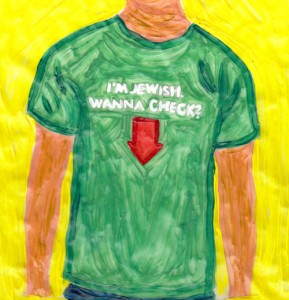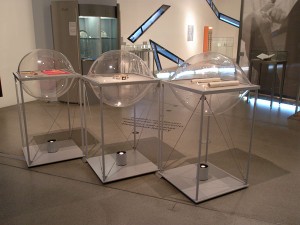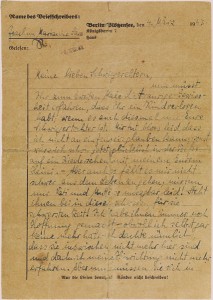 Eric Silverman’s long-awaited Cultural History of Jewish Dress was released last month in Bloomsbury’s prestigious fashion history series (formerly Berg). It brings up to date a subject which has long been in want of revision: Jewish clothing was last surveyed in 1967 – almost fifty years ago – by Alfred Rubens in A History of Jewish Costume. The scope of the book is broad, spanning three thousand years in regions and cultures as distant from one another as the Middle East, Russia, North Africa, Europe, and the USA.
Eric Silverman’s long-awaited Cultural History of Jewish Dress was released last month in Bloomsbury’s prestigious fashion history series (formerly Berg). It brings up to date a subject which has long been in want of revision: Jewish clothing was last surveyed in 1967 – almost fifty years ago – by Alfred Rubens in A History of Jewish Costume. The scope of the book is broad, spanning three thousand years in regions and cultures as distant from one another as the Middle East, Russia, North Africa, Europe, and the USA.
Drawing on the Torah, Mishnah, and Talmud, on a selection of secondary sources and newspaper articles in English, Silverman, a US-American anthropologist, chose an analytical rather than empirical approach. Instead of categorizing garments, he chronicles controversies fought over the ages about what Jews should and should not wear.
→ continue reading
In our permanent exhibition, there is a spot reserved for topics that are au courant: three prominently placed pot-bellied display windows that we call the “raviolis”.

“Ravioli” display windows in the permament exhibition © Jewish Museum Berlin, photo: Christiane Bauer
These display windows were filled once again with new exhibits for Purim, now. The new presentation looks at the festival from a feminist perspective and directs viewers’ attention to the latest developments substantially being shaped by Jewish women in the USA.
The focus of the presentation is on the two female characters of the Purim story that is read aloud at synagogue during the service: Esther and Vashti. Little attention has been paid to the latter for a long time. She was the first wife of the Persian King Ahasuerus, who cast her out because of her disobedience. He subsequently took the beautiful Jew Esther as a wife, who was shy and quiet, quite unlike the defiant Vashti. But over time Esther emerged from her reticence to transform into the courageous heroine we know, thwarting the conspiracy to murder the Persian Jews.
→ continue reading
In the archive of the Jewish Museum Berlin, there is a moving letter that Marianne Joachim wrote to her in-laws on 4 March 1943. That same day at the Berlin Plötzensee detention center, the young woman was executed.

Farewell letter from Marianne Joachim née Prager (1921 – 1943)
© Jewish Museum Berlin, photo: Jens Ziehe
What had happened? Marianne and Heinz Joachim supposedly joined a resistance group in 1941 led by Herbert Baum. A Jew and communist, Baum had been gathering like-minded friends around him since 1933 to generate resistance against the politics of National Socialism. On 18 May 1942, the group attempted to set fire to the anti-Soviet exhibit “The Soviet Paradise” in Berlin’s Lustgarten. Among the members jailed in short order and sentenced to death were Marianne and Heinz Joachim.
We learn from her letter that finding out that her husband had already been executed on 18 August 1942 in Berlin Plötzensee was the “heaviest stroke of fate” for Marianne. Her greatest concern was for her parents, Jenny and Georg Prager. They were deported in March 1943 to Auschwitz and Theresienstadt where they were killed. Marianne’s sister, Ilse, was able to escape on one of the last Kindertransports to England. Heinz Joachim’s father Alfons, died at the end of 1944 at the concentration camp Sachsenhausen. His mother, Anna, did not have a Jewish background and therefore survived the National Socialist period, as did his brothers. → continue reading
 Eric Silverman’s long-awaited Cultural History of Jewish Dress was released last month in Bloomsbury’s prestigious fashion history series (formerly Berg). It brings up to date a subject which has long been in want of revision: Jewish clothing was last surveyed in 1967 – almost fifty years ago – by Alfred Rubens in A History of Jewish Costume. The scope of the book is broad, spanning three thousand years in regions and cultures as distant from one another as the Middle East, Russia, North Africa, Europe, and the USA.
Eric Silverman’s long-awaited Cultural History of Jewish Dress was released last month in Bloomsbury’s prestigious fashion history series (formerly Berg). It brings up to date a subject which has long been in want of revision: Jewish clothing was last surveyed in 1967 – almost fifty years ago – by Alfred Rubens in A History of Jewish Costume. The scope of the book is broad, spanning three thousand years in regions and cultures as distant from one another as the Middle East, Russia, North Africa, Europe, and the USA.
